Articles
Will the Catholic Church ever consider a place for women?
Opinion | Articles | Myron J Pereira | 15-May-2022

The most significant event for the Indian Church in 2021 was the “judicial murder” of Jesuit Father Stan Swamy. It changed the way in which Catholics, hitherto timid and apologetic, saw the real face of their fascist government. It also changed the way in which Hindus, hitherto gullible about conversions to Christianity, saw in this aged and frail missionary a backbone of steel. Will the “Stan moment” become a “Stan movement”? Will the work, life and death of this Jesuit martyr continue to inspire the oppressed millions in India so that the spirit of the “Risen Stan” infuses them with indomitable courage?
That, after all, is the message of Easter. But it is also the logic behind a recently released book, If Not Now, When? It is based on reflections, testimonies, interviews and essays, largely by women who ask “disquieting feminist questions” (the book’s subtitle) and then proceed to give astonishing answers. Why women? Well, frankly, why not? Of all the silenced and oppressed masses throughout history, the largest group must surely be women — voiceless and faceless in so many cultures, and even in this day and age, dumb and powerless in the Catholic Church. The book compiles 25 articles jointly edited by two Catholic women and a Jesuit priest — Astrid Lobo Gajiwala, Kochurani Abraham and Father Prashant Olalekar — and published by the New Delhi-based Indian Social Institute, made available through the publishers or through Amazon.
The book discusses issues challenging women in three sections: Voices from the Margins; The Personal is Political; and Patriarchy, Power and the Catholic Church. The first section, Voices from the Margins, speaks of those women we rarely hear about — tribal people, Dalits, the impoverished and the uneducated. They are revealed here through the words of those who worked with them and gave form to their actions, usually protests and dissent. Why have protests and dissent become so significant today? Largely because today’s establishment, be it political or religious, promotes not just obedience but blind obeisance — conformity to its ideology. It sees any deviation as a threat deserving punishment.
Sadly, most of us are not critically aware and easily accept the lies of complaisant media or the state propaganda machine, and it becomes very difficult to sift truth from fake news. It is even more difficult to resist. That’s one important reason to read the narratives of resistance led by ordinary women and be amazed and inspired. In the second section, The Personal is Political, activists like Shabnam Hashmi, Susan Abraham, Vaishali Patil and Dayamani Barla speak of their personal journey and the political confrontation it led them to. Lawyer Lara Jesani of the People's Union for Civil Liberties asks why feminism is not discussed in Christian circles, and why it usually doesn’t form part of the Christian identity. The answers to these questions are thrashed out in the third section, Patriarchy, Power and the Church. It is becoming more and clearer to anyone with eyes to see that the present Roman Catholic Church is the last relic of an absolutist monarchy, arrogant in its ideology, disdainful of gender justice, secretive in its power play and hostile to all who envision change. No wonder many women keep asking themselves if they have any future in such a Church at all.
This reviewer, however, believes that they do, but this future lies in understanding their charism and being loyal to it rather than to a bogus orthodoxy. Briefly put, the post-Tridentine Church (1563-1965) was built on Roman hegemony and obedience. The Vatican model (1965-????) will be built on diversity, discernment and dissent. Already Pope Francis’ call for “synodality” is exploring areas in church life and mission never considered before. One of these, for example, is the place of interfaith dialogue as a normal component of living. Synodality places great emphasis on diversity and dialogue. It rejects the “one size fits all” approach that so characterizes the Roman model, whether in liturgy, theology or church administration.
True, most Catholics feel uncomfortable with this today because “it is not how we were brought up.” And here it is that women will come into their own, reclaiming the image of God as a relationship and redefining the Church as a nurturing mother, not as a harsh and disciplining father. Reading through the articles and interviews of If Not Now, When? does raise many disquieting questions. But then the answers are also there right before our eyes — if only we had the courage and the wisdom to see.
(Myron Pereira SJ is a Priest and media consultant based in Mumbai. The views expressed are personal)
Leave a comment
